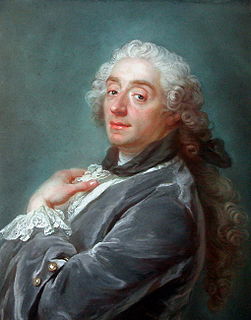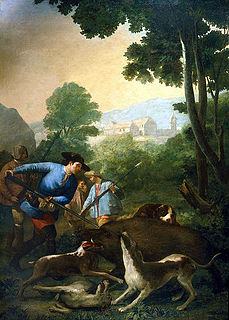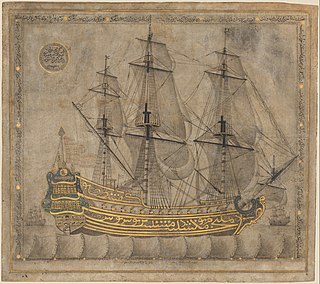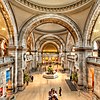
The Metropolitan Museum of Art of New York City, colloquially "the Met", is the largest art museum in the United States. With 6,953,927 visitors to its three locations in 2018, it was the third most visited art museum in the world. Its permanent collection contains over two million works, divided among 17 curatorial departments. The main building at 1000 Fifth Avenue, along the Museum Mile on the eastern edge of Central Park in Manhattan's Upper East Side, is by area one of the world's largest art galleries. A much smaller second location, The Cloisters at Fort Tryon Park in Upper Manhattan, contains an extensive collection of art, architecture, and artifacts from medieval Europe. On March 18, 2016, the museum opened the Met Breuer museum along Madison Avenue on the Upper East Side; it extends the museum's modern and contemporary art program.

François Boucher was a French painter, draughtsman and etcher, who worked in the Rococo style. Boucher is known for his idyllic and voluptuous paintings on classical themes, decorative allegories, and pastoral scenes. He was perhaps the most celebrated painter and decorative artist of the 18th century.

Aubusson is a commune in the Creuse department region in central France.

Tapestry is a form of textile art, traditionally woven by hand on a loom. Tapestry is weft-faced weaving, in which all the warp threads are hidden in the completed work, unlike cloth weaving where both the warp and the weft threads may be visible. In tapestry weaving, weft yarns are typically discontinuous; the artisan interlaces each coloured weft back and forth in its own small pattern area. It is a plain weft-faced weave having weft threads of different colors worked over portions of the warp to form the design.

Apache Tapestry is an open-source component-oriented Java web application framework conceptually similar to JavaServer Faces and Apache Wicket. Tapestry was created by Howard Lewis Ship, and was adopted by the Apache Software Foundation as a top-level project in 2006.

Jean-Baptiste Oudry was a French Rococo painter, engraver, and tapestry designer. He is particularly well known for his naturalistic pictures of animals and his hunt pieces depicting game.

Filippo Negroli was an armourer from Milan. He was renowned as being extremely skilled, and may be considered the most famous armourer of all time. Working together with his younger brothers Giovan Battista and Francesco in the Negroli family workshop headed by their father Gian Giacomo Negroli, Filippo was specialized in repoussé of armour, whereas his brother Francesco was renowned for his damascening skills. Filippo's pieces are considered especially remarkable because they were wrought in steel, rather than the more-easily worked iron that was the traditionally assumed medium.

The Devonshire Hunting Tapestries are a group of four magnificent Flemish tapestries dating from the mid-fifteenth century. These enormous works, each over 3 metres wide, depict men and women in fashionable dress of the early fifteenth century hunting in a forest. The tapestries formerly belonged to the Dukes of Devonshire, but in 1957 were accepted by HM Government in lieu of tax payable on the estate of the 10th Duke of Devonshire and allocated to the Victoria and Albert Museum, where they remain.

The Wolf and Fox Hunt is a c.1616 painting by Peter Paul Rubens now held in the Metropolitan Museum of Art in New York. It shows mounted and walking hunters chasing two wolves and three foxes. It marks the beginning of an intensive creative phase in which Rubens focuses on the theme of hunting.

The Franses Tapestry Archive and Library in London is devoted to the study of European tapestries and figurative textiles. It is the world’s largest academic research resource on the subject.

The Boar Hunt is a 1775 painting by Francisco de Goya, now in El Escorial. The earliest surviving tapestry cartoon by the artist, it belongs to his first series of cartoons, intended for a series of tapestries on hunting themes for Charles, Prince of Asturias and Maria Luisa of Parma. Its authorship is confirmed by its dimensions in receipts for the tapestries from the Real Fábrica archives.

The collection of the Metropolitan Museum of Art contains a lidded saltceller. Crafted in either 15th or 16th century Sierra Lione, the item is on view at The Met Fifth Avenue in Gallery 352.

The Farm at Les Collettes, Cagnes is an early 20th century oil on canvas painting by French artist Pierre-Auguste Renoir. The work is in the collection of the Metropolitan Museum of Art.

Boating is an 1874 painting by French artist Édouard Manet in the collection of the Metropolitan Museum of Art, New York.

Cypresses is a late 19th century painting by Dutch artist Vincent van Gogh. Done in oil on canvas, the painting depicts a pair of cypress trees in the French countryside. The work is currently on display in the Metropolitan Museum of Art.

A Cavalryman is a 19th-century painting by French artist Alphonse-Marie-Adolphe de Neuville. Done in oil on canvas, the painting depicts a French cavalryman on a yellow field. The work is in the collection of the Metropolitan Museum of Art.

The Dream of Aeneas is a mid 17th century painting by Italian artist Salvator Rosa. Done in oil on canvas, the work depicts a scene from the Roman poet Virgil’s Aeneid in which an embodiment of the Tiber river speaks to the Trojan hero Aeneas. The work is in the collection of the Metropolitan Museum of Art.

The Calligraphic Galleon is an example of Islamic calligraphy dating to the mid-18th century. Attributed to a calligrapher in the Ottoman Empire, the work depicts a galleon of the Ottoman navy. The ship is inscribed with the names of the Seven Sleepers, a group of men who were protected by the Abrahamic God, likely to confer a blessing of protection on the ship. It is in the collection of the Metropolitan Museum of Art.

The Leyniers family (/lɛnɪjɛ/) is a bourgeois family that appeared in Brussels in the 15th century and produced many high-level tapestry makers and dyers, experts in the art of dyeing in subtle shades the woolen threads destined for this trade.
Ono Otsū, also known known as Ono no Ozū, was a Japanese calligrapher and poet.





















